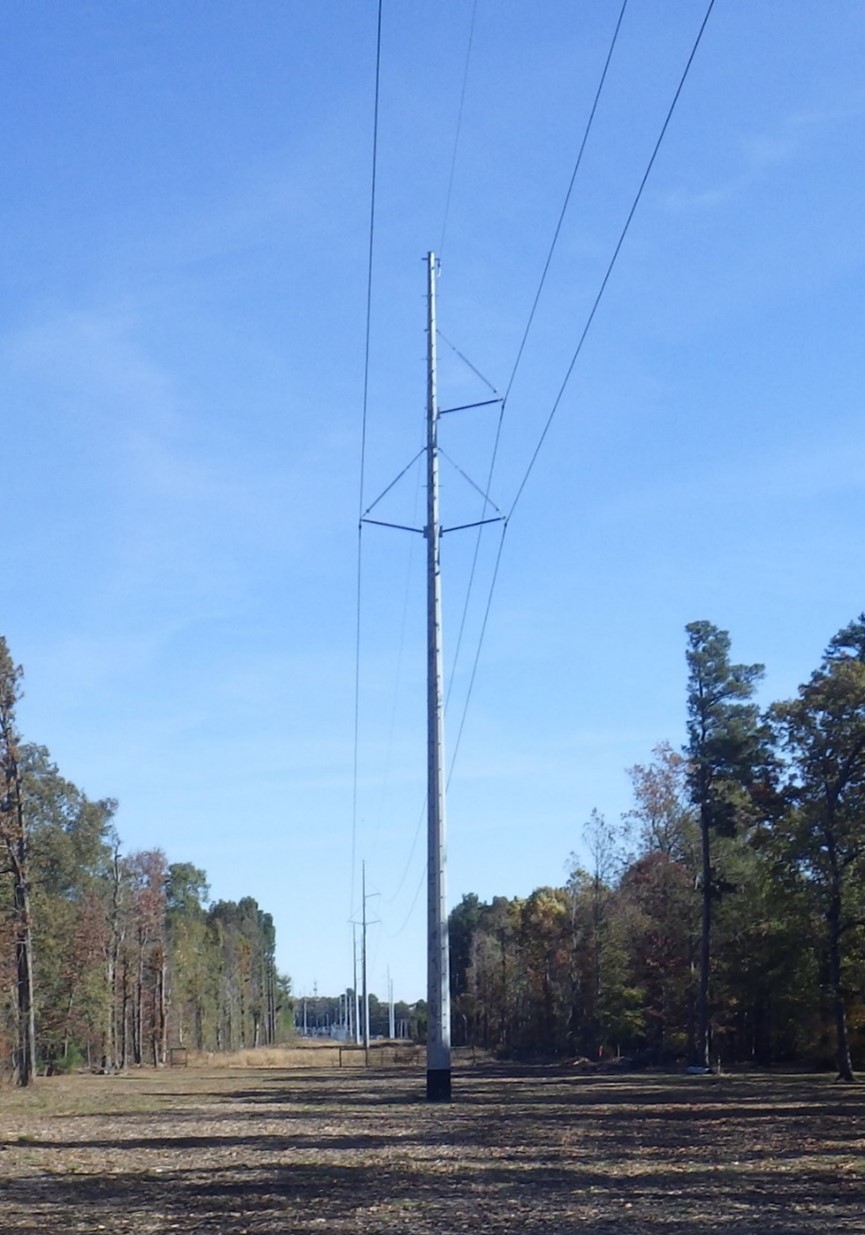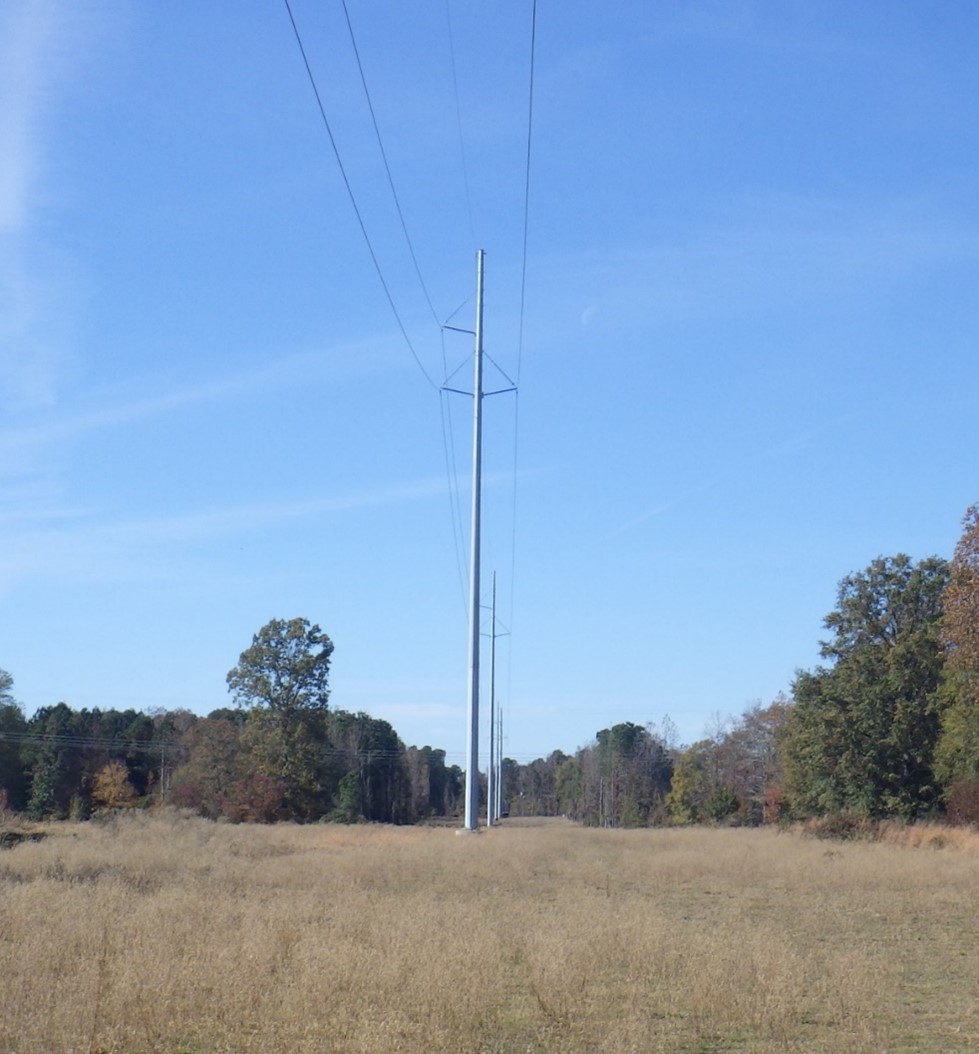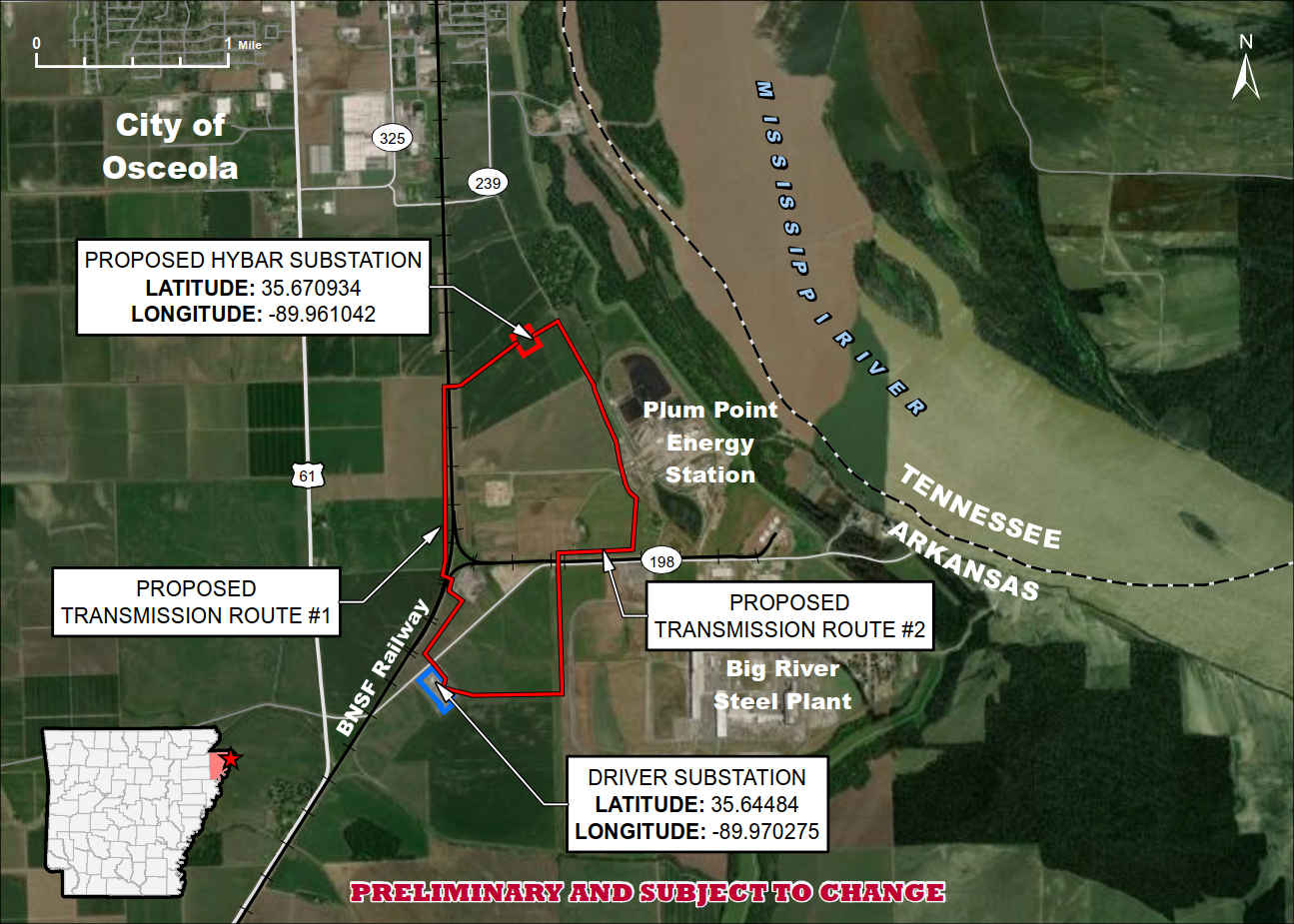 Entergy Arkansas is pleased to provide affordable, efficient, and reliable electricity to industrial, commercial, agricultural and residential customers. In November of 2022, Hybar, LLC announced it would be building a new rebar steel mini mill. The mill will be located south of the town of Osceola, Arkansas, on approximately 600 acres. Entergy Arkansas will support this growth opportunity by supplying electrical energy to the new facility.
Entergy Arkansas is pleased to provide affordable, efficient, and reliable electricity to industrial, commercial, agricultural and residential customers. In November of 2022, Hybar, LLC announced it would be building a new rebar steel mini mill. The mill will be located south of the town of Osceola, Arkansas, on approximately 600 acres. Entergy Arkansas will support this growth opportunity by supplying electrical energy to the new facility.
Entergy Arkansas is planning to construct a single 230 kV transmission line south of Osceola. The current project consists of building a transmission line between the existing Driver 230kV Substation and a new proposed Hybar substation located in Mississippi County, Arkansas. The proposed transmission line will have highly efficient and reliable terminal facilities at each of the substations it serves.
What are the benefits of the Hybar project?
The proposed project is a new 230kV transmission line connecting the Driver 230kV substation and the new proposed Hybar substation in Mississippi County. Hybar, LLC is constructing a new rebar mini mill south of Osceola, Arkansas. The new 230kV transmission line and associated facilities will supply power to the new mill, contributing to the continued industrial and economic growth of the region.
What transmission line construction is needed?
Entergy Arkansas plans to construct a new 230 kV transmission line connecting the Driver 230kV substation to the new proposed Hybar substation. The company will be using the latest and most highly efficient and reliable technology available in the industry to construct the transmission line and related switching equipment which includes a high-voltage circuit breaker, polymer braced post insulation and , modular steel or concrete pole structures. The overall project facilities will provide power to a new rebar mini mill being constructed in Mississippi County.
Typical 230 kV transmission line structure

230 kV transmission line map
Two potential routes for the 230 kV transmission line are being considered for the Hybar Transmission Project as shown in the following map. The proposed transmission line will be approximately two miles long with a 125-foot right-of-way located in Mississippi County.

The Hybar 230kV transmission line will be designed and built by Entergy Arkansas. The transmission line will be configured to avoid impacts to natural and human resources, as well as other obstacles or constraints. Land use in the vicinity of the project consists primarily of agricultural and industrial activities. Roads crossed or paralleled by the project include Mississippi County Roads 239, 623, 764 and 198 (Carson Lake Road). The eastern boundary of the site is adjacent to the Plum Point Energy Plant and the Big River Steel Mill.
One potential route for the proposed transmission line begins on the northeast side of the Driver 230kV Substation and trends northwest for approximately 900 feet (0.17 miles) crossing Arkansas State Highway 198. The transmission line then turns northeast and runs parallel to the existing Sans Souci-to-Driver and Dell-to-Sans Souci 500 kV transmission lines for approximately 1,800 feet (0.34 miles) before turning northwest and crossing under the two existing 500kV lines. At this point, the line trends northeast for approximately 380 feet (0.07 miles) before resuming a northwest trend and extending an additional 270 feet (0.05 miles) and crossing the BNSF railroad. From here, the line parallels the railroad northward for approximately 5,200 feet (0.98 miles) before turning due east crossing back over the railroad. The line then parallels East CR 764, trending northeast, for approximately 1,100 feet (0.21 miles) before terminating on the southwest side of the proposed Hybar substation.
The second potential alternative route exits the northeast side of Driver 230kV substation and trends southeast for approximately 830 feet (0.15 miles) before turning due east and paralleling the two existing 230kV transmission lines serving Big River Steel for approximately 2,375 feet (0.44 miles). The transmission line then turns due north extending approximately 3,875 feet (0.73 miles) crossing Arkansas State Highway 198. At this point, the transmission line turns east paralleling Arkansas State Highway 198 and the San Souci to Plum Point Energy 500kV transmission line for approximately 2,000 feet (0.37 miles) before turning northeast and extending 1,400 feet (0.26 miles). From here, the transmission line trends northwest, running parallel to Arkansas State Highway 239 for approximately 5,000 feet (0.94 miles) before turning southwest and extending approximately 800 feet (0.15 miles) before terminating on the northeast side of the proposed Hybar Substation.
Schedule overview
- Second- to fourth-quarter 2023: Development. Activities include environmental studies, engineering design evaluation and permitting.
- First-quarter 2024 to second-quarter 2025: Construction.
- Second-quarter 2025: Construction complete.
Transmission line and right-of-way considerations
Entergy Arkansas intends to make improvements in collaboration with community members and key leaders. All final decisions regarding new transmission line facilities will be made only after considering public input through the following sources:
- Customer feedback – Input from our customers, area landowners, residents and community leaders are essential in developing an effective and efficient project plan. Entergy Arkansas welcomes any comments that you may have.
- Public open house – Entergy Arkansas developed this webpage for the public to review the proposed project requirements. The webpage offers an email address for members of the community to offer comments or send in questions. The webpage will remain open, and comments will be received up until You may also call 501-213-0706 to leave a detailed message. Your call will be returned by one of our subject matter experts as soon as possible.
- Notice to landowners – All landowners of record on or near the proposed project area will be notified by mail.
Several factors must be considered when embarking on a project of this scale, including:
- Right-of-way for the transmission line and facilities – Entergy Arkansas will design its transmission line and facilities using existing standards for 230 kV right-of-way, which will be 125 feet wide based on utilization of single-pole steel or concrete structures. Additional right-of-way and/or substation terminal facilities may be required above the 125-feet range to accommodate guy wires, angle structures, terminating facilities and for clearing risk trees;
- Aesthetic considerations and other environmental factors – Modular steel or concrete poles will be used to provide tangent, angle turns and dead ends for the transmission line. These types of transmission line structures were selected to minimize the aesthetic displeasure of the installation;
- Health and safety – Safety is a priority for Entergy Arkansas and, in accordance with the requirements set forth in the National Electrical Safety Code, the company will construct and operate the proposed electrical facilities at its standard voltage design and will observe reasonable safety precautions to prevent jeopardizing the public safety. Construction methods and activities in the field will also meet U.S. Department of Labor Occupational Safety and Health Organization requirements. Entergy Arkansas also maintains and follows its own safety policies and procedures in the Entergy Transmission and Distribution Safety Manual;
- Regulatory and permitting – The Arkansas Public Service Commission requires the company to file an application for approval of a Certificate of Environmental Compatibility and Public Need to construct the proposed 230kV transmission line. The APSC may conduct a public hearing in connection with Entergy Arkansas’ application. The purpose of the hearing would be for the commission to hear evidence of the general economic and environmental impact of the project and to determine the reasonable of the Proposed Route for the transmission lines, as opposed to individual objections to the presence of the facilities, and to approve a route that minimizes generally adverse economic and environmental consequences. However compensation for any claimed damages will not be awarded by the APSC, but rather, such damages would be considered by a circuit court in the appropriate jurisdiction. The U.S. Army Corps of Engineers, as well as other federal and state agencies, requires the company to file for approval of various permits for the new transmission line.
Next steps
- Customer contact and site access – Through a contract with external consultants, landowners will be contacted for assistance in developing plans to temporarily access new right-of-way prior to construction. These plans may include ground surveys, soil testing and test borings.
- Construction phase – The proposed electrical facilities will be designed and constructed by Project & Construction Management personnel under the direction, supervision and design specifications of Entergy Arkansas. Vegetation management, electrical construction and final testing will be performed by pre-qualified electrical contractors under the supervision of Entergy Arkansas personnel in a sequential operation of surveying, clearing, structure erection, conductor installation, testing and clean-up. The first operation is to survey the transmission route to establish the centerline, edge of right-of-way and profile of the transmission line. Centerline staking and profiling may require cutting some trees and undergrowth. Right-of-way clearing, if necessary, will also be performed by contracted crews under the supervision of Entergy Arkansas personnel. Trees outside of the right-of-way that endanger the safe and reliable operation of the transmission line will be cut to provide necessary clearance.
Structure installation takes place in three phases: transporting, assembling, and erecting. Material is transported to each location where structures are assembled, as much as is practical, on the ground; the poles are then set according to the appropriate construction method based upon soil type. Once the structure is assembled, installing conductor is the next critical step. Many vehicles and items of equipment are required to install the conductor. As with vehicles and equipment associated with other construction phases, crews will exercise care to minimize damage to the terrain and landowner premises.
Frequently Asked Questions
What experience does Entergy Arkansas have in building transmission lines?
Entergy Arkansas owns and operates approximately 939 circuit miles of extra high voltage transmission lines of 345 kV or greater; 196 circuit miles of transmission lines of 230 kV; 3,832 circuit miles of transmission lines of 161 kV and lower; transmission substations, distribution substations and associated facilities necessary to provide electric service to the region.
What is the project's timeframe?
While this project will still need to be approved by the Arkansas Public Service Commission, we expect to begin construction in the first quarter of 2024 with completion scheduled for the second quarter of 2025.
Should I be concerned about safety issues?
Entergy Arkansas’ top priority is to have a safe, accident-free environment. Detailed on-site safety measures will be developed to meet the specific needs of the project, community, and impacted areas.
How big is the footprint of the Hybar Transmission Project?
The proposed 230kV transmission line would be approximately 2 miles in length with an associated 125-foot right-of-way, totaling approximately 30 acres.
Where should I direct any questions or concerns regarding this project?
If you have any questions about the project, please contact us at HBTransmission@entergy.com or by calling 501-213-0706 and leaving a detailed message.
